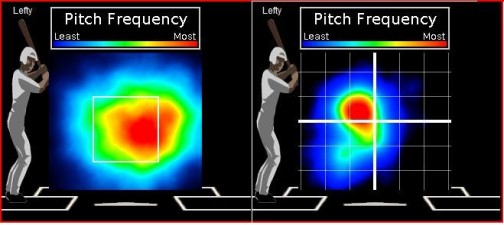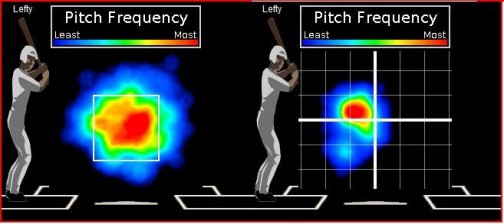The earlier discussion on Matt Cain sent me to Baseball Analytics to see if the heat charts for Matt showed any signs that he is controlling the way fly balls are put into play against him. For the moment, I’m limiting the discussion to left-handed batters. The PITCH f/x data covers 2008 through 2010. In that time, Matt faced left-handed batters and right-handed batters nearly equally, allowing 32 home runs to LHB and 31 HR to RHB.
The first graph represents all pitches to LHB during the regular season. The chart on the left shows position of the pitch in the strike zone. The chart to the right indicates movement of the ball.
Note that pitches above the X-axis on the movement chart do not indicate balls that are rising. They are pitches that are falling less that expected. Here is the explanation:
Each grid line represents 4 feet per second and the x-axis is placed at 13 ft/sec down which is the avg vertical speed of a typical pitch as it crosses home plate. A pitch one grid line above the center axis is falling at 9 ft/sec as it crosses home plate.
Cain’s most frequent pitches to LHB move in on them and stay up more than expected.
Compare that to his pitches that induce fly balls:
LHB are hitting pitches away in the strike zone, and once again pitches that are staying up.
Next, the fly ball outs.
The graph matches his overall fly ball location and movement well. What happens on home runs?
It’s a bit of a double whammy. LHB hit the pitch down and in hard. These pitches do not stay up like his out pitches, and also tend to break toward the batter more.
One interpretation of the data is that the lack of drop on Cain’s pitches to LHB fools them, causing the to swing under the pitch. They fail to make solid contact, resulting in a fly out. Note that his home runs tend to be on the fringes of his usual locations for left-handed batters. The also tend to drop more normally, allowing the batter better contact. Cain reliably makes pitches that are easy to hit in the air, but tough to hit out of the park.
Without posting the same pictures for RHB, the home runs seem more random. His home run pitches tend to stay up more than his out pitches on fly balls, and the location of home runs and most of his fly outs are the same.
My conclusion is that Matt does a good job of keeping the ball up in the strike zone. His pitches drop less than expected, and batters tend to get under them too much. I’m surprised that after six seasons in the league, batters haven’t done a better job of adjusting to his pattern.






thanks for the analysis. interesting that the batters haven’t adjusted. perhaps, it’s not so easy to adjust one’s swing to a particular pitcher.
Dave – Matt Cain’s results definitely defy nature. I am working on another angle with him and hope to have it out soon. -Jeff Z.
Awesome write-up. Thanks.
Pingback: Can Matt Cain Sustain His Low HR/FB Rate? | FanGraphs Baseball
Has anyone asked a hitter that’s faced him?
@Will Carroll: Not that I know of.
Pingback: Infield Fly Balls and the Coliseum « Knuckleballs
Pingback: Me…Elsewhere! | Baseballin' on a Budget
@Will Carroll
The closet I saw in my brief search is from Jimmy Rollins in the playoffs.
Rollins talked about Cain and attributed his effectiveness to late movement and changing of speed more than to any of the other factors.
SO it is possible that the “late movement” is the ball not being where hitters expect it to be.
In addition I took this idea and ran with it a little further and pulled the pitch fx data from the 2008 through 2010 seasons and compared pitchers with “rising fastballs” and their home run rates and it appears that there is a relationship.
My regression estimated that with every additional inch of vertical movement there is a corresponding drop in home run rate of 0.35%. So with a league average home run rate of 10% every inch corresponds with a drop of 3% from league average.
I think that it needs further study but it is an interesting and possibly enlightening idea.
@Scott Willis: Very cool, Scott.
Pingback: Is Matt Cain Lucky or Good: Analyzing HR/FB Rates
Pingback: Stats and Selection Bias Daily Options Report
Pingback: Matt Cain is Controversial. Really. « Bay City Ball | Giants' Baseball with a Side of STATS!
Pingback: Does IFFB% Correlate with HR/FB Rates? | Community – FanGraphs Baseball
Pingback: 2011 Fantasy Projections, No. 78: How San Francisco Giants’ Matt Cain Continues to Defy Advanced Stats | Fantasy Baseball Insiders